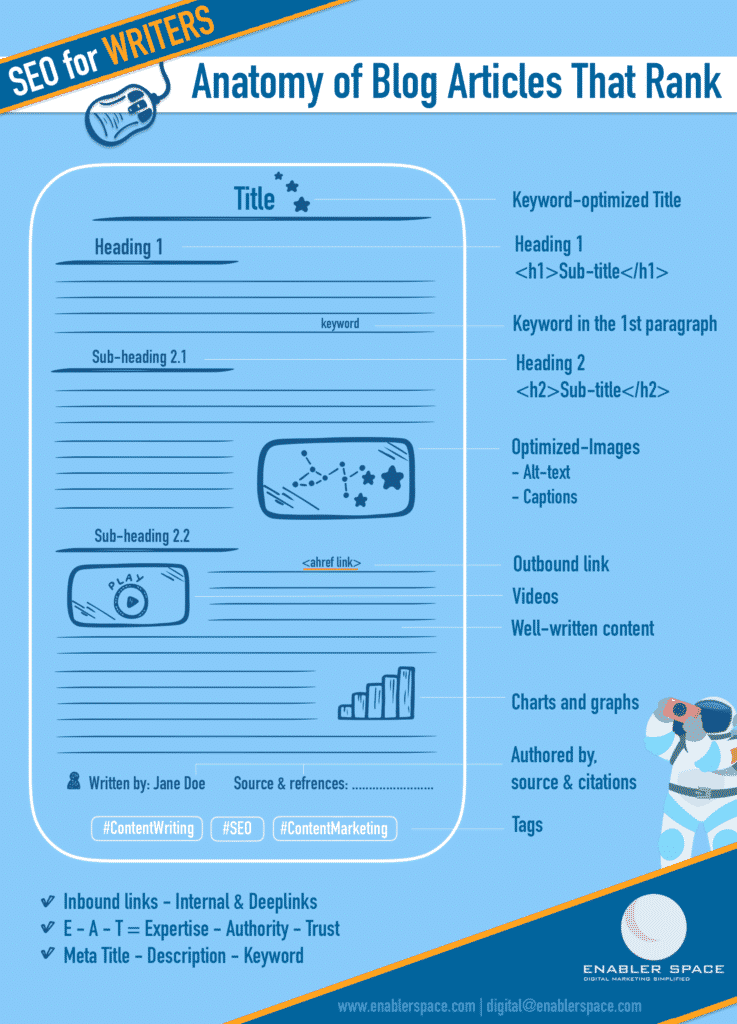Ever wonder why some articles rank better? This is even when they’re of similar quality with another that has been written on the same topic. There are some elements of web content that extends a little more than about writing itself; or we can refer to it as having some knowledge about SEO for writers.
While the quality of an article is one of the most important SEO (search engine optimization) features that helps it to rank better, there are a handful of other SEO-friendly elements of an article that would benefit any writer.
Elements of the SEO-friendly Article
Let’s take a look at some of the most important ones here.
- Title: Make sure your main keyword and/or keyphrase is in the Title
- Heading 1: From a writer’s perspective, we’re referring to segmenting the article by headers, so it’s easier to read and better structured. From the search engine spider’s point of view, in the code it would appear in the < h1 >tag, which is one of the key tags that the spider uses to understand the content of the webpage and article better.
- Heading 2: If you’re going to be structuring the article so that it is more organized and easier to read, might as well add sub-headings. And these are also viewed by the search engine spider, so go ahead to use sub-headings.
- Keyword in the 1st paragraph: Search spiders read the code of a webpage from top-to-bottom left-to-right. This means having the main keyword and key phrase you’d like the article to rank for in the first paragraph, would ensure that the search spider would not miss it, incase the page doesn’t render fully or time-out when the spider’s crawling. It also sends a signal that this is the article’s main concept since it’s important enough to be mentioned in the first paragraph.
- Optimized images: What this means is making sure that the image is not stretched, blurred or pixelated while ensuring the image size isn’t too big either. Also, make good use of the alt-text and captions. Not only would this help search engines make more sense of the article, but also helps increase chances of the image to rank in the vertical search (image search).
- Outbound links: Don’t be afraid to add some outbound links if you feel there are references that would be useful to the reader. If it naturally makes sense, it would not hurt the article’s SEO score or rankings. Just make sure you’re linking out to credible sources.
- Videos: Why not embed some useful videos? Putting the effort to create some short clips to compliment the article content shows both the reader and search engine the genuine intent to craft and share useful content. Embedding other’s videos would also be alright if you feel the content in the video compliments your article and would help the reader truly understand the article better.
- Well written content: This one is a given. A well researched, structured and presentable content would have better probability to rank higher in the search engine results.
- Charts and graphs: This is similar to the idea of adding images and videos that support and compliment the article so that the reader can more easily grasps the content.
- Authored by: Give the article a face and a name. An article written by someone knowledgeable in that topic with similar writing and credentials elsewhere, would help search engines more accurately identify the value of the article.
- Sources, references and citations: Always give credit where it’s due. It helps search engines understand the intent of the writer to provide accurate information, but more importantly, this is about digital ethics as well.
- Tags: Ensuring you add tags to your blog article makes it easier for search engines to understand the content; in other words, what topic it is related to. However, don’t spam the tags. Ensure you’re adding tags only where it makes sense for the readers as well.

And there we go, a list of useful know-how on SEO for writers. Besides this list, there are a few other FAQs (frequently asked questions) about writing web content and blog articles that helps it to rank better. We’ve compiled a few here for you.
Frequently Asked Questions About SEO for Writers
How many times should the keyword be repeated?
Don’t overdo this. As a general rule of thumb, keep the article natural. Remember you’re writing for the human audience. Keep the search engines as a second. Repeating the same words too often isn’t always good for the reader.
What word count should I aim for?
This is subjective. Not too short. Not too long. And if you have to choose between short and long, always go for long with really good structure and content layout, using the headers and sub-headers. Aim for around 1,000 words. Anything too short isn’t useful for either the reader or search engines to understand what is it you’re trying to present to the reader. There will always be this tug-of-war when it come to handling SEO for writers.
Does the title have to be a question?
You’ll notice that in the search engine results page, there is a snippet that shows questions with drop-down answers. These are taken from content and articles that answers those questions well. So questions are always good to help search engines better organize web content. It is also useful for the readers; that is why we have FAQs such as this one. But again, the main idea is not to overdo anything just for the sake of SEO.
Always put the reader and audience first when crafting content, before search engines.
Where else can I learn more about SEO and Content Marketing?
There’s a lot that has been written about SEO (search engine optimization) and content marketing. You can also learn more about the basics for SEO and content marketing from our blog.

